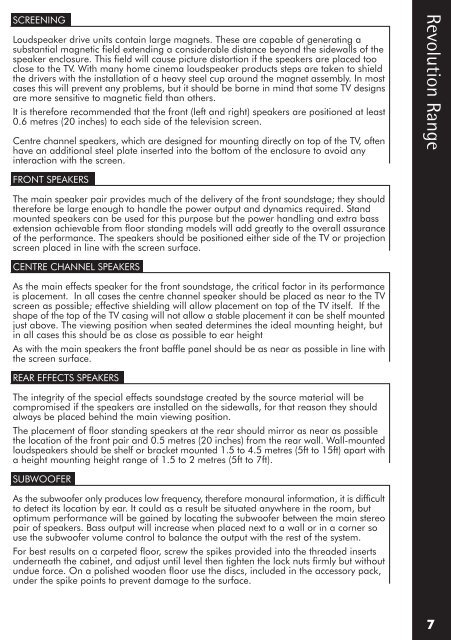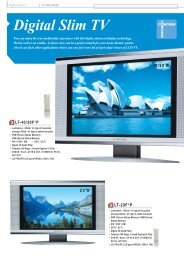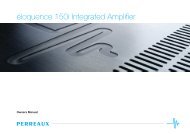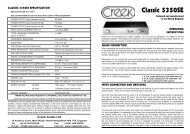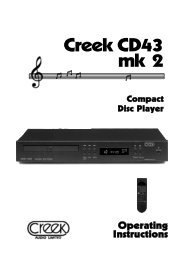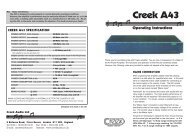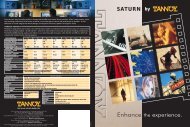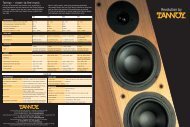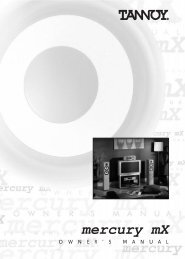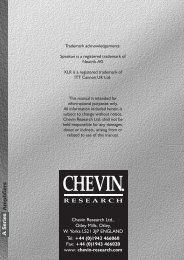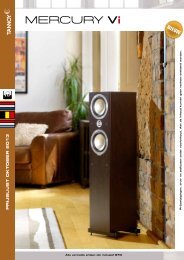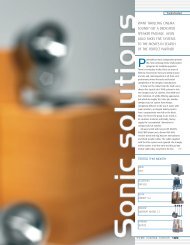Revolution by
Revolution by
Revolution by
Create successful ePaper yourself
Turn your PDF publications into a flip-book with our unique Google optimized e-Paper software.
SCREENING<br />
Loudspeaker drive units contain large magnets. These are capable of generating a<br />
substantial magnetic field extending a considerable distance beyond the sidewalls of the<br />
speaker enclosure. This field will cause picture distortion if the speakers are placed too<br />
close to the TV. With many home cinema loudspeaker products steps are taken to shield<br />
the drivers with the installation of a heavy steel cup around the magnet assembly. In most<br />
cases this will prevent any problems, but it should be borne in mind that some TV designs<br />
are more sensitive to magnetic field than others.<br />
It is therefore recommended that the front (left and right) speakers are positioned at least<br />
0.6 metres (20 inches) to each side of the television screen.<br />
Centre channel speakers, which are designed for mounting directly on top of the TV, often<br />
have an additional steel plate inserted into the bottom of the enclosure to avoid any<br />
interaction with the screen.<br />
<strong>Revolution</strong> Range<br />
FRONT SPEAKERS<br />
The main speaker pair provides much of the delivery of the front soundstage; they should<br />
therefore be large enough to handle the power output and dynamics required. Stand<br />
mounted speakers can be used for this purpose but the power handling and extra bass<br />
extension achievable from floor standing models will add greatly to the overall assurance<br />
of the performance. The speakers should be positioned either side of the TV or projection<br />
screen placed in line with the screen surface.<br />
CENTRE CHANNEL SPEAKERS<br />
As the main effects speaker for the front soundstage, the critical factor in its performance<br />
is placement. In all cases the centre channel speaker should be placed as near to the TV<br />
screen as possible; effective shielding will allow placement on top of the TV itself. If the<br />
shape of the top of the TV casing will not allow a stable placement it can be shelf mounted<br />
just above. The viewing position when seated determines the ideal mounting height, but<br />
in all cases this should be as close as possible to ear height<br />
As with the main speakers the front baffle panel should be as near as possible in line with<br />
the screen surface.<br />
REAR EFFECTS SPEAKERS<br />
The integrity of the special effects soundstage created <strong>by</strong> the source material will be<br />
compromised if the speakers are installed on the sidewalls, for that reason they should<br />
always be placed behind the main viewing position.<br />
The placement of floor standing speakers at the rear should mirror as near as possible<br />
the location of the front pair and 0.5 metres (20 inches) from the rear wall. Wall-mounted<br />
loudspeakers should be shelf or bracket mounted 1.5 to 4.5 metres (5ft to 15ft) apart with<br />
a height mounting height range of 1.5 to 2 metres (5ft to 7ft).<br />
SUBWOOFER<br />
As the subwoofer only produces low frequency, therefore monaural information, it is difficult<br />
to detect its location <strong>by</strong> ear. It could as a result be situated anywhere in the room, but<br />
optimum performance will be gained <strong>by</strong> locating the subwoofer between the main stereo<br />
pair of speakers. Bass output will increase when placed next to a wall or in a corner so<br />
use the subwoofer volume control to balance the output with the rest of the system.<br />
For best results on a carpeted floor, screw the spikes provided into the threaded inserts<br />
underneath the cabinet, and adjust until level then tighten the lock nuts firmly but without<br />
undue force. On a polished wooden floor use the discs, included in the accessory pack,<br />
under the spike points to prevent damage to the surface.<br />
7


